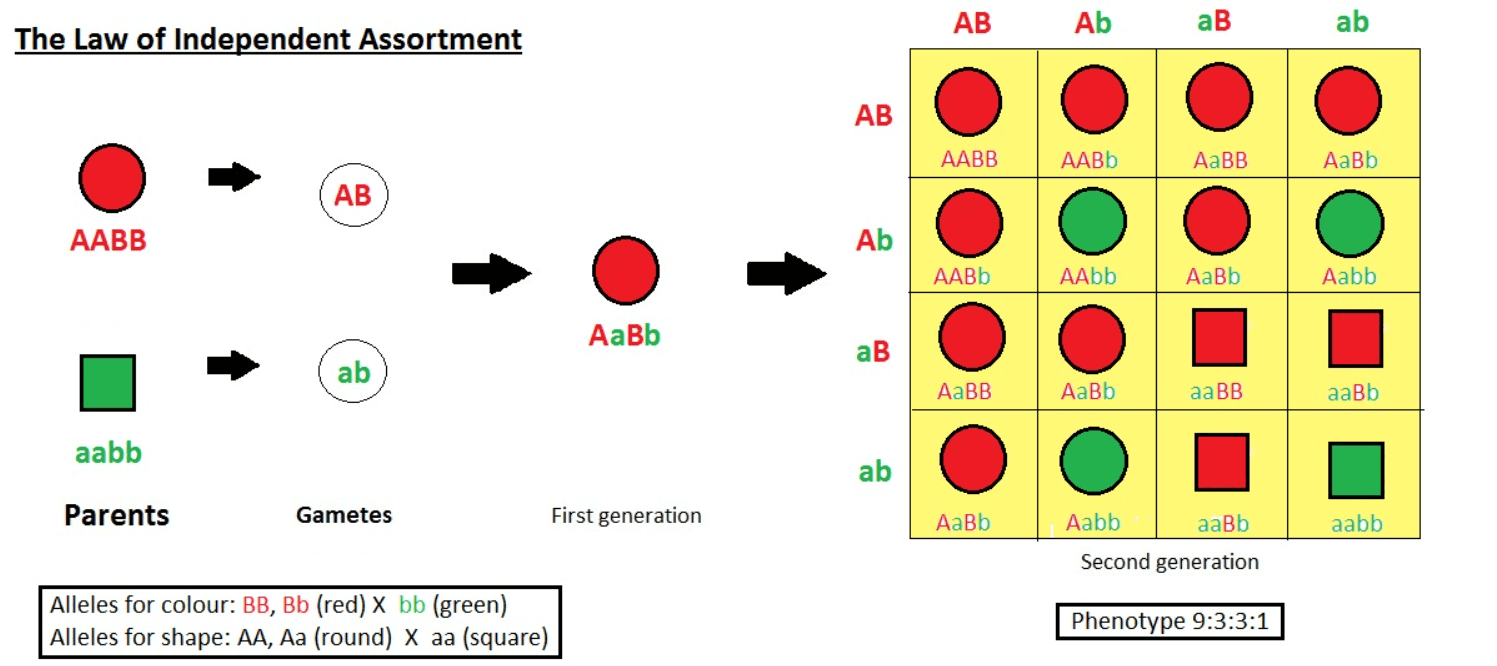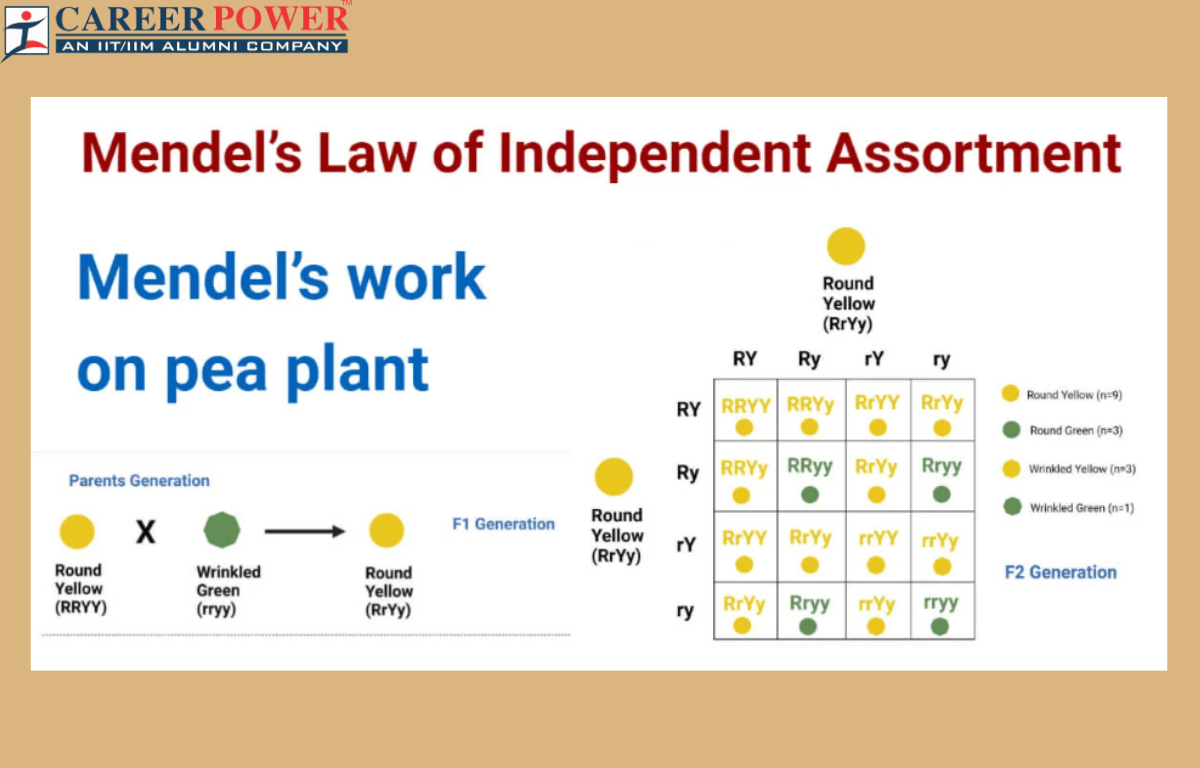Mendel’s Laws, formulated by Gregor Mendel, describe the inheritance patterns of traits in organisms. Mendel’s laws are also counted as one of the important topics in Biology. The first law is the law of segregation, which states that organisms inherit two alleles for each trait, one from each parent, which segregates during gamete formation. The second law is the law of independent assortment, which asserts that different traits segregate independently, leading to various combinations in offspring. Ans the third law the law of dominance. These laws laid the foundation for modern genetics. Here we have briefly described the Law of Independent Assortment below in the article.
Law of Independent Assortment
The law of Independent assortment states that during the formation of gametes, the alleles for different traits segregate, or assort, independently of each other. This means that the inheritance of an allele for one trait does not affect the inheritance of an allele for another trait. This principle was formulated by Gregor Mendel based on his experiments with pea plants and is one of the fundamental principles of Classical genetics.
What is Independent Assortment?
Independent assortment is a principle in genetics that states during the formation of gametes (sperm and egg cells), the alleles (different forms of a gene) for different traits segregate, or assort, independently of each other. This means that the inheritance of an allele for one trait does not affect the inheritance of an allele for another trait. This principle is one of the fundamental concepts in Mendelian genetics and is the result of the random orientation of homologous chromosomes during metaphase I of meiosis. Independent assortment leads to genetic variation, as it generates different combinations of alleles in offspring.

Examples of the Law of Independent Assortment
The law of independent assortment states that genes located on different chromosomes assort independently during the formation of gametes. This means that the inheritance of one gene does not affect the inheritance of another gene. The examples discussed below will highlight how genes on different chromosomes segregate independent assortment of these traits.
- Mendel’s Pea Plant: In one of Mendel’s experiments, he studied two traits in pea plants: seed color (yellow or green) and seed texture (smooth or wrinkled). These traits were located on different chromosomes. According to the law of independent assortment, the inheritance of seed color is independent of the inheritance of seed texture. This means that a plant with yellow, smooth seeds can produce gametes with combinations like yellow, smooth or yellow, wrinkled, and various other combinations, all following the principle of independent assortment.
- Fruit Fly Eye Color and Wing Shape: In fruit flies, eye color and wing shape are controlled by genes located on different chromosomes. The law of independent assortment predicts that the inheritance of eye color (say, red or white) is independent of the inheritance of wing shape (normal or vestigial). As a result, different combinations of eye color and wing shape can occur in the offspring, demonstrating the independent assortment of these traits.
Law of Independent Assortment Experiment
The law of independent assortment states that alleles for different traits segregate, or assort, independently of each other during the formation of gametes. This means that the inheritance of an allele for one trait does not affect the probability of inheriting an allele for a different trait.
One of the classic experiments illustrating this law was conducted by Gregor Mendel, the father of modern genetics, in the mid-19th century. Mendel studied traits in pea plants and performed numerous crosses to observe patterns of inheritance. He specifically looked at traits like seed color (yellow or green) and seed texture (smooth or wrinkled) among others.
Mendel’s experiments involved crossing plants that were true-breeding for different traits. For example, he crossed plants that always produced yellow seeds with plants that always produced green seeds. He then observed the traits of the offspring (first filial generation or F1 generation) and later allowed the F1 plants to self-pollinate to produce the second filial generation (F2 generation).
Through his experiments, Mendel found that traits like seed color and seed texture were inherited independently of each other. This means that the allele for seed color did not influence the inheritance of the allele for seed texture, and vice versa. Mendel’s work laid the foundation for our understanding of inheritance patterns and the basis of the law of independent assortment.
Process of Performing the Experiment of Law of Independent Assortment
Here is a step-by-step breakdown of Mendel’s experiment illustrating the law of independent assortment. Through these meticulous experiments and observations, Mendel deducted the principle of inheritance, including the law of independent assortment, which states that the different traits segregate independently of one another during the formation of gametes.
Step 1: Selection of Traits – Mendel chose traits in pea plants that exhibited clear variations, such as seed color (yellow or green) and seed texture (smooth or wrinkled).
Step 2: True-Breeding Plants – Mendel started with true-breeding plants for each trait. True-breeding plants always produce offspring with the same traits as the parent when self-pollinated.
Step 3: Cross-Pollination – Mendel cross-pollinated plants with different traits. For example, he crossed a true-breeding plant with yellow seeds (YY) and a true-breeding plant with green seeds (yy). This cross resulted in the F1 generation.
Step 4: Observation of F1 Generation – The offspring of this cross (F1 generation) all had yellow seeds. This indicated that the yellow trait was dominant over the green trait.
Step 5: Allowing F1 Plants to Self-Pollinate – Mendel allowed the F1 generation plants (all with yellow seeds but heterozygous Yy) to self-pollinate.
Step 6: Observation of F2 Gneration – In the F2 generation, Mendel observed a ratio of 3:1 for seed color. This means that approximately 3/4 of the plants had yellow seeds, and 1/4 had green seeds. This 3:1 ratio is a characteristic result of a monohybrid cross (involving one trait).
Step 7: Further Experiments with Another Trait – Mendel performed similar experiments with other traits, like seed texture (smooth or wrinkled). He chose true-breeding plants with differing textures and observed the patterns of inheritance in the F1 and F2 generations.
Step 8: Observation of Independent Assortment – Crucially, Mendel also performed dihybrid crosses, considering two traits simultaneously, such as seed color and seed texture. By doing this, he observed that the inheritance of one trait (e.g., seed color) did not affect the inheritance of another trait (e.g., seed texture). This independent assortment of traits is a key aspect of the law of independent assortment.



 50 Vegetables Name for Kids in English a...
50 Vegetables Name for Kids in English a...
 Food Chain: Definition, Types, Examples,...
Food Chain: Definition, Types, Examples,...
 Human Respiratory System: Definition, Di...
Human Respiratory System: Definition, Di...













